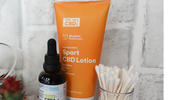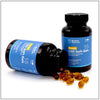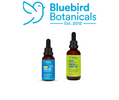What To Do After A Workout: 5 Tips For A Healthy Post-Exercise Routine

Few things in life feel quite as nice as that "I just freakin' crushed it!" post-workout high... And it makes sense considering exercise has been shown to boost mood and energy levels, while reducing feelings of stress and anxiety.
However, in order to keep the good times rolling long after your workout, it’s important to give your body some proper attention to aid its recovery.
From simple stretching and meditation to self-massage, there are all sorts of ways to care for your body, mind, and soul after a good ol’ sweat session.
Here are our 5 tips for building a happy, healthy post-exercise routine.
1. Rehydrate
Speaking of sweat session, one of the main changes that takes place in your body during exercise is a loss of fluids from sweating.
When you workout, your body heats up from muscle contractions and the breakdown of fats, proteins, and carbohydrates for fuel. This rise in core temperature is perfectly natural, but if it were left unchecked would result in damage to muscle tissue, internal organs, and more.
So to prevent any damage from taking place, your body responds by increasing blood flow to your skin and the amount you sweat, which allows heat to escape more easily from the body and cools you down.
However, the more you sweat, the more water (and minerals) you lose... And maintaining proper levels of hydration within the body is vitally important for a lot more than just temperature regulation.
In fact, even just mild dehydration has been linked to declines in cognition, immunity, physical performance, and recovery; while more severe dehydration can result in serious consequences such as organ failure and death.
But fear not, friends... There's an easy solution: Drink up!
By prioritizing rehydrating after exercise, you can make sure you're replenishing important fluids and minerals that were lost through sweat. Not only does this help prevent the ill effects of dehydration, it also benefits the recovery and rebuilding processes that take place after a workout... Meaning better gains for your efforts!
It's important to note that not all fluids are created equal.
For one, beverages that are high in caffeine, alcohol, and sugar can have a diuretic effect—meaning they make you urinate more. And since urination obviously corresponds to a loss of fluids and minerals, it's best to avoid these types of beverages until after you've had a chance to rehydrate with some good ol' H₂0.
Pro Tip: Adding a pinch of sea salt or trace mineral drops to your water is a great way to quickly replace some of the electrolytes lost during exercise.
2. Refuel
As we mentioned above, when you workout your body burns through nutrients like fats, carbohydrates, and proteins to fuel your activities... And just like with the fluids you lose during exercise, it's important to replenish these valuable nutrients after a workout to ensure your body continues to function properly.
A lot of opinions exist on when and what types of foods to eat following exercise, but in reality, there's no one-size-fits-all approach to refueling.
There's simply too much variance in the types and intensity of workouts people do, individual schedules, and dietary restrictions to claim there's a perfect post-workout meal or snack.
So to keep things simple, strive for balance when refueling after a workout.
Consuming foods with a healthy mix of fats, proteins, and carbohydrates will go a long way in ensuring your body has a good baseline of macronutrients available to function normally.
From there, feel free to prioritize your needs based upon what types of workouts you do and their intensity.
For instance, if you just crushed a heavy lifting day, it could be smart to get a little extra protein to assist your body in rebuilding damaged muscle fibers... Or if you're a distance runner, chances are your body burns through a lot of glycogen during your runs, and the best way to restore glycogen is by consuming foods rich in healthy carbohydrates, like sweet potatoes.
The point is, while your specific needs may be a little different from someone else's... At a foundational level, we all run on the same types of fuel: fats, proteins, and carbs.
So when it comes to refueling after exercise, start with the basics, then specify from there according to your individual needs.
Pro Tip: If you're always on the go, healthy snack options can be tough to come by... Luckily, these CBD Power Bars are quick, easy, portable, and delicious!
3. Self-Massage
Self-massage is a great post-exercise ritual. It can help stimulate blood flow, melt tension from sore muscles, and it's easy to do!
All you need is your hands, maybe a bit of oil, and enough strength leftover from your workout to dig into your troublesome areas.
Can't get to a certain spot? No problem. There are a ton of options you can use for areas that are hard to reach.
In recent years, high-tech massage guns like those from Hyperice and Therabody have exploded in popularity, allowing users to experience professional-grade muscle relief all from the comforts of home.
Even massage rollers have evolved from the days of the simple foam roller...
For instance, the R8 deep tissue massage roller features a unique design that takes the awkward maneuvering out of muscle rolling, allowing you to easily target particular muscles that needs a little TLC.
Pro Tip: Looking for something a little simpler (and more affordable)? Get a tennis ball or baseball, find a good spot, and dig in!
4. Stretch it out
Stretching after a workout not only leaves your limbs feeling relaxed, but it also improves flexibility and range of motion, helps prevent injuries, and increases blood and nutrient flow to the muscles.
There are many different types of stretching, including static stretching, dynamic stretching, ballistic stretching, myofascial release, and more... with each variant offering its own benefits for stiff muscles.
Some of the best post-workout stretches are long, static holds, where the muscle relaxes after being held in a taut, stretched position for a certain duration of time.
Examples of this type of static stretching includes yoga poses where you hold a particular position for one minute to several minutes at a time, focusing on the breath, and allowing the affected muscle to slowly relax more and more.
Pro Tip: If you're new to stretching or simply want to learn some new moves, there are a ton of free, online yoga classes that will guide you step by step through a full-body routine.
5. Level up your recovery routine
Stretching and self massage are great places to start when it comes to recovering well, but a lot of options exist to help you take it a step farther.
Tools like saunas and steam rooms have been used in many cultures for thousands of years for the purposes of purification, cleansing, and healing.
This is because temporarily increasing the body’s core temperature induces a hormetic response that helps condition the body for future heat stressors. You can read all about this process involving heat shock proteins.
There are also certain products that you can take to help you recover better.
For instance, did you know that CBD can support your muscles and joints, as well as promote post-exercise recovery?†
Try an oil or capsule that includes CBDA, such as Bluebird's Complete formula, to harness the power of both the raw and heated forms of hemp and finish your workout routine on a good note.
Pro Tip: Always consult your doctor whenever introducing new products to your routine, and prioritize buying from brands that utilize third-party testing.









